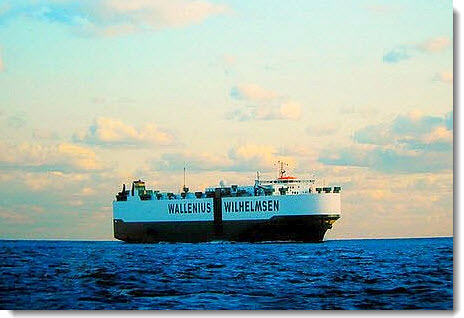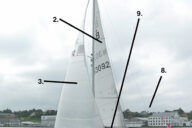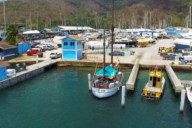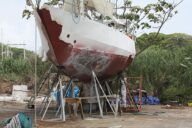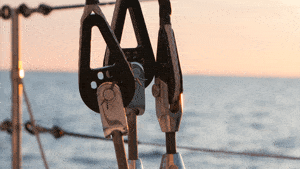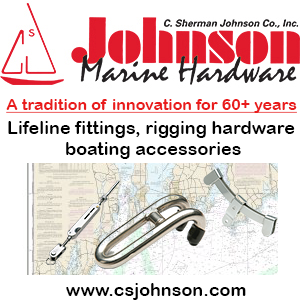Capt John of skippertips.com reviews using drift bearings to analyze risk of collision.
Sail in the Gulf Stream (English Channel or similar) and you can bet behemoths abound there too. They will often be steaming at twenty to thirty knots. Consider that a freighter or tanker pushing 20 knots will eat up liquid real estate–and anything in its path–at 2000 yards every three minutes. Or 2 nautical miles every 6 minutes. If you pick up a ship on the horizon at 6 miles, you may have just minutes before it’s on top of you.
Your number one determinant for risk of collision will be drift bearings. This action will always be in addition to other means (i.e. AIS or radar if installed). Again, the electronics are not a substitute for visual bearings. The Navigation Rules are quite clear on the requirement of bearings in collision risk situations. Train your sailing crew or partner in the sea-tested, works-every-time, no-batteries-required techniques described below.
When you first sight a ship on the horizon, take a bearing to the vessel. Use a hand bearing compass. Choose a spot on a prominent part of the vessel’s hull, like the bow. At night, use a masthead light (a white light on the mast).

Take three successive bearings spaced two to three minutes apart. Shoot bearings to the same exact point each time. Write down the three bearings in your log. You will use your entries to determine “bearing drift” (more on this later).
Look at the three successive bearings you wrote down. Are they steady bearings that show no change or too slow a rate of change for comfort (i.e. one or two degrees)? Or do those bearings show a rapid rate of change from right to left or from left to right.
I believe you should see at least 3° or more of change between bearings in the same direction (all to the right or all to the left) to indicate a low risk of collision.
Continue to shoot more bearings to the vessel until you have determined that risk of collision no longer exists. How will you know this? Use these two criteria: When you can see the stern of the other vessel and her distance continues to increase in a direction away from your vessel, she no longer presents a risk of collision.
Use this same rule of thumb when sailing near smaller power vessels or other sailing vessels. Realize at all times that situations can change from docile to dangerous. Just another reason that you should continue to shoot bearings until the vessel no longer presents a threat to your vessel.
How “Bearing Drift” Shows Risk of Collision
Look for one of three types of bearing drift: steady bearing drift; left bearing drift; right bearing drift. Follow the examples below along with the illustrations. Print these examples to help train your sailing crew in this vital sailing seamanship skill.

- Steady Bearing Drift (left-side illustration)
020M, 021M, 020M What do these bearings mean?
Steady bearings–or a rate of bearing change less than three degrees indicate a high risk of collision. Track the ship and take action as necessary to avoid collision (see my eBook “Navigation Rules Made Easy” for more on course and speed maneuvers to avoid collision). - Left Bearing Drift (middle illustration)
047M, 040M, 033M What do these bearings mean?
Rapid changes in bearing to the left (counter-clockwise) with more than three degrees between bearings show fast left bearing-drift. This indicates a low risk of collision. It appears that the ship will pass ahead of you.Realize that bearings are dynamic and can change at any time to slow or steady bearings. Track the ship until it has passed you and you see just the stern of the ship. This tells you that the ship no longer offers a risk of collision. - Right Bearing Drift (right-side illustration)
075M, 080M, 085M What do these bearings mean?
Rapid changes in bearing to the right (clockwise) with more than three degrees between bearings show fast right bearing-drift. This indicates a low risk of collision. It appears that the ship will pass down your starboard side at a safe range (distance). This ship appears to be stationary (i.e. adrift or “dead in the water”), so you will not see her entire stern section. Once you pass her, the range (distance) should increase. Use this to indicate that the risk of collision has passed.
~~~~~~~~~~~~~~~~~~~~
*Note: in some cases, bearings will change fast and the risk of collision can still be quite high. This can happen when you are close to another vessel, close to a large vessel, or close to a vessel engaged in towing. As long as the range (distance) between vessels increases, risk of collision will be low. Continue to track vessels like this until you are convinced that risk of collision has passed.

